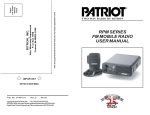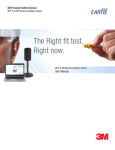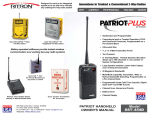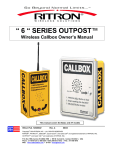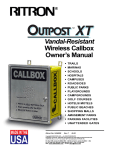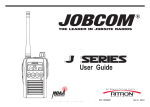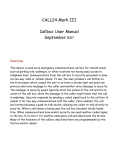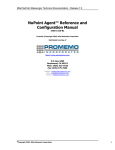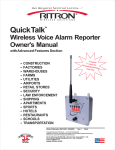Download Ritron SST-444D Owner`s manual
Transcript
PATRIOT ® SST "FOUR SERIES"
OWNER'S MANUAL
"FOUR SERIES" HANDHELDS
N
COMP
ACT
COMPA
USEew
UL
TRA
-SMALL
ULTRA
TRA-SMALL
R
Fea
t
u
PR
OFESSIONAL TW
OWAY RADIOS
PROFESSIONAL
TWOO-W
res
• Ten-channel capability
• Easier, enhanced programming method
• 2, 3, and 4 Watt models
• Quick-change battery
• Drop-in charge capable
feature (VHF only)
• Weather scan
• Channel scan
• Easy-to-hear, high audio output
• Built-in Quiet Call® Interference Eliminator
• Digital Quiet Call® Interference Eliminator
ACCESSORIES
OPTIONAL ACCESSORIES:
TO ORDER, CALL 800-USA-1-USA.
BPS-6N-SC ...... Spare/ Replacement SST Battery
BPS-6N-MH ..... Replacement High Capacity Battery
BCPS-AD
Single-Well Drop-in Charger
RHD-1X
RHD-6X
Single Ear Headset
Behind-the-head Earset
AFS-150 ........... VHF Molded Flex Antenna
AFS-450 ........... UHF Molded Flex Antenna
RHD-1X
RHD-4X
RHD-5X
RHD-6X
BPS-6N-SC/BPS-6N-MH
Spare Battery
............ Single Ear Headset
............ Dual Ear Headset
............ Lightweight Over-the-ear Earset w/ In-line PTT
............ Lightweight Behind-the-head Earset w/ In-line PTT
RSM-3X ........... Remote Speaker Microphone
REP-2 ............... Low Profile Earphone
CCL-B ............. Cigarette Lighter Charger
RHD-4X
BCPS-4AD
4-Well Drop-in Charger
MHS-A ............. Cordura Holster w/quick release
Dual Ear Headset
BCPS-4AD ...... 4-Well Drop-in Charger: SST
BCPS-AD ......... Single-Well Drop-in Charger: SST (Overnight)
BCC-PS ........... Drop-in High-rate Charger/
Conditioner; for SST Models only
RHD-5X
RSM-3X
Over-the-ear Earset
Remote Speaker Mic
Call RITRON for complete listings
MHS-A
Swivel Holster
The NEW Patriot SST "Four Series" models contain updated programming features, and program differently than
other SST portables. These radios provide more channels and feature Digital Coded Squelch and Channel Scan
capability.
ii
Have questions? Call 800-USA-1-USA (800-872-1872) or visit our website at www.ritron.com
TABLE OF CONTENTS
DESCRIPTION
PAGE
ACCESSORIES
Optional Accessories ............................................................................ i i
INTRODUCTION
Features .................................................................................................
"Four Series" Model Numbers .............................................................
Inspection ..............................................................................................
FIG-1: Belt Clip Installation ...............................................................
1
1
1
1
CONTROL & OPERATION ........................................................................... 2
FIG-2: Radio Controls and Connectors ............................................. 2
OPERATION
On-off/ Volume .....................................................................................
Channel Selection ...............................................................................
Receive .................................................................................................
Selective Signaling Squelch ..............................................................
Monitor ..................................................................................................
Quiet Call Tone Codes (Interference Eliminator Codes) ..................
Transmit ................................................................................................
Radio Alert Tones ................................................................................
Optional Alert Tones ............................................................................
Weather Scan (VHF Radios Only) .......................................................
FIG-3: To Scan Weather Frequencies ...............................................
3
3
3
3
3
3
3
4
4
4
4
SCAN CHANNEL OPERATION
How Scanning Works ............................................................................
Priority Scanning ..................................................................................
Busy Channel Delete ...........................................................................
Last Channel Scanned Alert Tone .....................................................
5
5
5
5
RADIO PROGRAMMING ............................................................................. 5
INTERFERENCE ELIMINATOR TONE CODES
TABLE 2: Programmable QC (Quiet Call®) Tone Codes .................. 6
TABLE 3: Programmable DQC (Digital Quiet Call®) Tone Codes ... 6
NOTE:
page 3
DESCRIPTION
PAGE
!! CAUTIONS — ALL RADIOS !!
Observe Caution in the Following Environments to Maximize the
Life of Your Radio Equipment ............................................................ 7
Exposure to Radio Frequency Energy ................................................ 7
BATTERIES
FIG-4: Battery Access and Installation ..............................................
Optional Charging Accessories ...........................................................
Batteries ................................................................................................
Charging ...............................................................................................
General .................................................................................................
Battery Maintenance and Conditioning ............................................
8
8
9
9
9
9
TROUBLESHOOTING
Notes .................................................................................................... 10
Chart .................................................................................................... 10
FCC LICENSE REQUIRED
FCC Regulations ................................................................................. 11
Service ................................................................................................. 11
How to Obtain an FCC Radio License .............................................. 11
LIMITED WARRANTY ................................................ INSIDE BACK COVER
TABLES:
1. Quiet Call Codes and Frequencies ................................................ 5
2. Digital Quiet Call Codes and Frequencies ................................... 5
FIGURES:
1. Belt Clip Installation ........................................................................
2. Radio Controls and Connectors ......................................................
3. To Scan Weather Frequencies .......................................................
4. Battery Access and Installation ......................................................
1
2
4
8
Refer to pages ii and 8 for Accessory information.
Call RITRON at 800-USA-1-USA (800-872-1872) for a complete Accessory listing or visit our website at www.ritron.com
RITRON,
INC.
1-800-USA-1-USA
(1-800-872-1872)
Have
questions?
Call 800-USA-1-USA
(800-872-1872) or visit our website at www.ritron.com
iii
INTRODUCTION
FEATURES
"FOUR SERIES" MODEL NUMBERS
This manual covers the Ritron SST "Four Series" radios.
These radios are compact, programmable two-way handhelds
designed to operate in a professional FM communications band
(VHF or UHF business available). Each radio is equipped with
these features:
• Push-button operating controls.
The Push-To-Talk
(PTT) and Channel buttons are on one side of the radio, and
the On/ Volume Up, Volume Down/ Off and monitor controls
on the top.
VHF
MODEL
SST-144 ............. (Patriot) ........ (4-Watt, 4 Channel)
UHF
SST-446XP ........ (Patriot) ........ (2-Watt, 4 Channel)
SST-444 ............. (Patriot) ........ (3-Watt, 4 Channel)
• Up to 10-channel capability. Each channel can be
programmed to contain a unique set of operating frequencies and options.
The model number located on the back of the radio case indicates its operating band.
• Channel scanning. A scan channel can be created that
allows selective scanning of the other channels programmed into the radio. The scan channel has many
features, including Priority Scanning and Busy Channel
Delete.
• Wide or narrow band operation. Each channel is
programmable for wide or narrow band transmit operation.
• High or low transmit power. Each channel can be
programmed for high or low transmit power to satisfy your
needs for extended range or battery conservation. (This
option is not available on the SST-446XP)
To attach the belt clip to the radio:
Place the clip on the back of the
radio case, aligning the screw
hole in the clip with the hole in
the case. Tighten the screw.
See FIG-1 below.
MODEL
• Quick-change battery pack and drop-in charger capabilities. See Accessories on the previous page.
• QC (Quiet Call) and DQC (Digital Quiet Call)
intereference eliminator codes. Each channel can be
programmed from a list of 51 QC sub-audible codes or 83
DQC digital privacy codes.
FIG-1: BELT CLIP INSTALLATION
PHILLIPS
HEAD
SCREW
BELT
CLIP
VHF radios are designed to operate on up to ten
channels within the 5 MHz band between factory
standard 150 and 155 MHz.
UHF radios are designed to operate on up to ten
channels within the 10 MHz band between
factory standard 460 and 470 MHz.
CH
INSPECTION
Make sure the package includes a radio, antenna,
rechargeable battery pack and belt clip. Examine
the equipment immediately after delivery and report any damage to your shipping company.
CAUTION:
Use only the included Phillips head
screw, because a longer screw could
damage radio electronics.
• A full line of radio accessories. Ritron offers a
complete line of accessories to accommodate your specific
requirements. (See page ii for Accessories)
page 1
Have questions? Call 800-USA-1-USA (800-872-1872) or visit our website at www.ritron.com
CONTROL & OPERATION
1
6
ANTENNA
The flexible antenna radiates and receives radio
signals. Screw the antenna base all the way into the
threaded bushing on top of the radio.
NOTE: Use only the type of antenna furnished with the
radio. VHF and UHF antennas are not
interchangeable.
2
ON/ VOLUME UP
To switch the unit On, press the On/ Volume Up button;
the speaker will beep a number of times equal to the
channel. If the radio turns on to the Scan Channel it will
emit the Resume Scan Beep. Once the radio is On,
press this button to increase volume.
3
VOLUME DOWN/ OFF
Press the Volume Down/ Off button to decrease
volume. To switch Off the unit, press and hold this
button until the speaker emits a double beep.
4
PUSH-TO-TALK SWITCH
(PTT)
Press and hold the PTT when transmitting; release it to
receive.
5
CHANNEL SELECT
Press the button once and the radio will beep a number
of times equal to the current channel number. Pressing
the button again within 3 seconds will increment the
channel and the radio will beep the new channel.
When the Scan Channel is selected the radio will emit
the Resume Scan Beep.
BATTERY ACCESS DOOR (CASE BOTTOM)
The battery access door may be removed to access the
battery pack. Refer to Battery Access & Installation, FIG-4,
page 8.
7
8
page 3
2
AUDIO ACCESSORY JACK
The audio accessory jack is used to plug in earphone
options, and, in conjunction with the charge jack, to connect
an optional remote speaker/ microphone or a single- or dualear headset. This jack is also used for PC programming.
9
9
LD
3
O
/H
FF
O
E
N
O
M
LU
O
V
The battery pack may be charged through this jack using
the supplied RITRON charger cube. Refer to Accessories,
page 1, for additional charging options.
10
8
CHARGE JACK
4
5
SPEAKER
10
CH
The speaker, located behind the front grille, allows you to
hear calls on your channel.
11
11
MICROPHONE
The microphone allows your voice to be heard in
transmissions to other radios. Speak in a normal tone;
shouting does not improve your listener's reception.
12
6
12
DROP-IN CHARGING CAPABILITY
Two contacts, in the bottom of the radio, permit charging
the battery pack with an optional drop-in charger. Refer to
Optional Charging Accessories, page 8.
IMPORTANT:
7
1
JACK COVER
This rubber cover seals out dust and moisture, etc. Snap
the cover into the audio accessory jack and charge jack
openings when the jacks are not in use.
FIG-2:
RADIO CONTROLS & CONNECTORS
CHARGE THE BATTERY PACK before using the radio for the first time. Refer to Batteries, pages 8 and 9
RITRON,
INC.
1-800-USA-1-USA
(1-800-872-1872)
Have
questions?
Call 800-USA-1-USA
(800-872-1872) or visit our website at www.ritron.com
page 2
OPERATION
ON-OFF/VOLUME
SELECTIVE SIGNALING SQUELCH
To switch on the radio - press the On/Volume Up button. The radio will beep a number of
times equal to the current channel number. If the radio turns on to the Scan Channel it will
emit the Resume Scan Beep.
To activate tone squelch - simultaneously press both of the volume buttons.
Hold for a second or two before releasing. When tone squelch is turned on,
the handheld sounds one beep. When carrier squelch is on, the radio emits a
“double beep.”
To adjust the volume - press the volume up button until you reach the desired level. You
should hear noise and any broadcasts on the channel.
To turn off the radio - press and hold the Off/Volume Down button until two tones sound.
To determine whether the radio is on - press the volume down button. If the radio is on,
noise or activity on the channel is heard.
Note: If you continue to hold down the volume buttons after the beep (or
double beep), the radio will start beeping repeatedly. This means that squelch
is turned off. Release the buttons. To restore squelch, press and hold both of
the volume buttons until the radio sounds a beep or double beep.
MONITOR
CHANNEL SELECTION
To change channels - press and release the Channel button. The radio will beep a number
of times equal to the current channel number. Pressing the Channel button again within 3
seconds will increment the channel and the radio will beep the new channel number.
To monitor the channel - press one of the volume control buttons. When you
press the volume up or the volume down button, squelch turns off and all radio
traffic on the channel (and noise) sounds in the speaker.
Example: If you select channel 2, the handheld will beep twice.
If the highest channel number is selected and you press the Channel button, the radio
resets to channel 1.
A one-channel radio will beep only once when you press the Channel button.
If the Scan Channel is selected The radio will emit the Resume Scan Beep.
RECEIVE
QUIET CALL TONE CODES
(Interference Eliminator Codes)
Tone codes filter out static, noise and reduce unwanted "chatter"
on radio channels. When you operate on a frequency with a tone
code, you screen out most interference. This allows you to communicate with less interference and to hear only those users in
your radio group.
IMPORTANT!
To hear calls from other users - adjust the volume as desired. The radio can receive
broadcasts while the Push-To-Talk button is not being pressed. Whether or not you hear
these broadcasts depends upon the squelch settings.
There are two types of squelch used in the SST "Four Series" portable. First is carrier
squelch. This lets you hear all broadcasts on your channel strong enough for the radio to
detect, and silences noise. Second is one of the selective signaling or “tone squelch”
formats available on the SST. This allows you to screen out “on-channel” broadcasts that
do not carry the correct code programmed for the radio.
Note: It is possible that the beginning of a call might be missed while the radio is in battery
saver mode. If this happens, ask the caller to repeat the message.
page 3
All radios in the talk group must operate on the
same frequency and tone code.
TRANSMIT
Normally, you should not transmit until no one is talking on the channel.
To transmit - hold down the Push-To-Talk button and with the radio four inches
away talk into the microphone. Speak in a normal tone, since talking louder will
not improve the listener’s reception.
Have questions? Call 800-USA-1-USA (800-872-1872) or visit our website at www.ritron.com
OPERATION
RADIO ALERT TONES
OPTIONAL ALERT TONES
WEATHER SCAN (VHF RADIOS ONLY)
The handheld responds to certain instructions by sounding a beep
or series of tones. These tones can tell you whether the radio is
working as you expect.
The SST "Four Series" radio can
be programmed using the
RITRON PC Programmer for
optional alert tones.
TO SCAN STANDARD U.S. WEATHER FREQUENCIES
and hear weather forecasts, follow the steps in FIG-3 below.
To resume normal two-way operation, turn the radio off, then
on again.
Power On/Self Check “OK”
When it is first turned on, the radio runs a quick “self test” to
confirm basic functions. The radio then beeps the number of times
equal to the channel number selected. The radio is then ready to
use.
Error Tones
However, if the “self test” detects a diagnostic error, an error tone
sounds. Alternating tones (the second is longer and lower pitched)
indicate the radio frequency synthesizer is malfunctioning. Turn off
the radio and try again. A long, low-pitched tone means the battery
voltage is too low to operate the radio. In this case, recharge the
battery. If you cannot correct a problem, consult an authorized
Ritron service facility or Ritron.
Channel Select
When the Channel button is pressed, the radio beeps a number of
times equal to the current channel number. Pressing the Channel
button again will increment the channel and the radio will beep the
new channel number.
Recharge Battery Alert
As the battery voltage approaches the minimum required “operating
voltage” the radio will emit a short beep every 20 seconds to alert
the user that the battery will soon need recharging. Once the
battery charge drops below the required “operating voltage,” the
radio emits a long, low tone and turns itself off. If you turn the
radio back on, it will beep again and shut itself off. Recharge the
battery.
Tone Squelch
When you press and hold both Volume buttons at the same time, a
single beep will sound to indicate that tone squelch is on. A
“double beep” means that carrier squelch is on.
page 3
Receive Squelch Tone
A short tone sounds at the end
of each received transmission
to indicate that you may
transmit.
1. PRESS & HOLD UNTIL
THE "RADIO OFF"
TONES ARE HEARD,
THEN RELEASE.
Busy Channel TX Inhibit
If a user is transmitting on your
radio frequency without your
tone, you will not be allowed to
transmit. The radio will beep a
series of long, low tones while
the PTT is held down (like a
busy signal).
WEATHER SCAN AUTOMATICALLY
TUNES TO NOAA BROADCASTS
2. PRESS & HOLD
3. PRESS & RELEASE THE RADIO WILL
START BEEPING.
Transmitter Time Out
A low tone followed by a
higher-pitched tone sounds and
the transmitter automatically
shuts off if you hold down the
PTT button longer than the
programmed Time-out. The
radio automatically switches to
receive mode. Authorized
service personnel can turn off
this feature.
4. CONTINUE HOLDING THE
CHANNEL BUTTON UNTIL THE
BEEPING STOPS, THEN RELEASE
IT & LISTEN.
5. TO FIND THE NEXT ACTIVE
WEATHER CHANNEL, PRESS &
RELEASE THE CHANNEL BUTTON.
Transmit Clear To Talk Beep
A short tone sounds after the
PTT has been released to
indicate that you have stopped
transmitting.
FIG-3:
TO SCAN WEATHER FREQUENCIES
RITRON,
INC.
1-800-USA-1-USA
(1-800-872-1872)
Have
questions?
Call 800-USA-1-USA
(800-872-1872) or visit our website at www.ritron.com
page 4
CHANNEL SCAN OPERATION
RADIO PROGRAMMING
Channel scanning allows you to listen to broadcasts on many different radio channels. To
utilize this feature the radio must be PC programmed by your dealer with a
Scan Channel containing a list of the channels to be scanned.
The SST "Four Series" radio is PC programmed using software developed by
Ritron, Inc. All programming and alignment of the SST "Four Series" radio must
be performed by a licensed radio service technician. Consult your Ritron
dealer for re-programming of your radio, or contact Ritron at 800-872-1872 for
referral to an authorized Ritron dealer.
_______ MHz
____
2
_______ MHz
_______ MHz
____
Priority Scanning
3
_______ MHz
_______ MHz
____
4
_______ MHz
_______ MHz
____
5
_______ MHz
_______ MHz
____
6
_______ MHz
_______ MHz
____
7
_______ MHz
_______ MHz
____
8
_______ MHz
_______ MHz
____
9
_______ MHz
_______ MHz
____
10 _______ MHz
_______ MHz
____
The priority scan option allows you to periodically monitor a Priority Channel, even if the
radio has stopped on another channel. With Priority Scan enabled, the first channel in the
scan list is the Priority Channel. The radio can also be programmed to transmit only on the
Priority Channel when scanning, if desired. The SST "Four Series" handheld can also be
programmed to sound a Priority Channel Beep whenever the radio receives on the Priority
Channel when scanning.
Nusiance Channel Delete
If one of the channels in the scan list is so busy that you want to temporarily delete it from
the list, press and hold the channel button until the Resume Scan Beep sounds.
Scanning will resume indicating the channel has been deleted. (NOTE: The first channel
in the scan list cannot be deleted). The deleted channel will now be skipped in the
scan list. The deleted channel will be returned to the scan list if the radio is turned off, or
when the radio channel is changed using the Channel Select button.
Last Channel Scanned Alert Tone
When changing channels with the Channel Select button, an alert tone will sound
immediately after the channel number beeps to indicate the last channel that received a
message when the radio was scanning. This will identify the channel on which the last
message was received, and allow uninterrupted transmission on that channel without the
constraints of scanning. You can then press the Channel Select button to return to the
scan channel.
page 5
SCAN LIST
!
!
!
!
!
!
!
!
!
!
____
____
____
____
____
____
____
____
____
____
!
!
!
!
!
!
!
!
!
!
TRANSMIT
BANDWIDTH
(W/N)
_______ MHz
TRANSMIT
POWER
(H/L)
RECEIVE
TONE CODE
1
INVERT
TRANSMIT
FREQUENCY
When transmitting from the Scan Channel, the handheld will go to the last channel on
which a signal was received and transmit. After you release the PTT the radio will pause
to allow time for a response, sound the Resume Scan Beep, and resume scanning.
When receiving a call on a channel being scanned, the radio will stop scanning to let you
hear communications on that channel. After the transmission has ended the radio will
pause before it resumes scanning to allow you time to respond. The Resume Scan Beep
will sound when the radio resumes scanning.
TRANSMIT
TONE CODE
RECEIVE
FREQUENCY
Use the following chart to log your SST "Four Series" radios programming:
CHANNEL
Using the Channel Select button, select the Scan Channel. The radio pauses, sounds a
Resume Scan Beep, and then repeatedly checks each channel of the scan list in the
order they were programmed into the list.
INVERT
How Scanning Works
____
____
____
____
____
____
____
____
____
____
____
____
____
____
____
____
____
____
____
____
(Enter the Channel numbers from the Chart above)
1
2
3
4
5
Priority ________
______________
______________
______________
______________
6
7
8
9
______________
______________
______________
______________
Have questions? Call 800-USA-1-USA (800-872-1872) or visit our website at www.ritron.com
INTERFERENCE ELIMINATOR TONE CODES
TABLE 1: PROGRAMMABLE QC (QUIET CALL) TONE CODES
QUIETCALL
CODE
01
02
03
04
05
06
07
08
09
10
11
12
13
14
15
16
17
18
19
20
21
22
23
24
25
26
page 3
Other
Radio Brands
Tone
Freq.
Code
( Hz )
67.0
71.9
74.4
77.0
79.7
82.5
85.4
88.5
91.5
94.8
97.4
100.0
103.5
107.2
110.9
114.8
118.8
123.0
127.3
131.8
136.5
141.3
146.2
151.4
156.7
162.2
XZ
XA
WA
XB
SP
YZ
YA
YB
ZZ
ZA
ZB
1Z
1A
1B
2Z
2A
2B
3Z
3A
3B
4Z
4A
4B
5Z
5A
5B
QUIETCALL
CODE
27
28
29
30
31
32
33
34
35
36
37
38
39
40
41
42
43
44
45
46
47
48
49
50
51
Other
Radio Brands
Freq.
Tone
( Hz )
Code
167.9
173.8
179.9
186.2
192.8
203.5
210.7
218.1
225.7
233.6
241.8
250.3
69.4
159.8
165.5
171.3
177.3
No Tone
183.5
189.9
196.6
199.5
206.5
229.1
254.1
6Z
6A
6B
7Z
7A
M1
--------------------
TABLE 2: PROGRAMMABLE DQC (DIGITAL QUIET CALL) TONE CODES
DIGITAL
QUIETCALL
CODE
INVERT
OF
THE
CODE
DIGITAL
QUIETCALL
CODE
INVERT
OF
THE
CODE
DIGITAL
QUIETCALL
CODE
INVERT
OF
THE
CODE
DIGITAL
QUIETCALL
CODE
INVERT
OF
THE
CODE
023
025
026
031
032
043
047
051
054
065
071
072
073
074
114
115
116
125
131
132
134
047
244
464
627
051
445
023
032
413
271
306
245
506
174
712
152
754
365
364
546
223
143
152
155
156
162
165
172
174
205
223
226
243
244
245
251
261
263
265
271
306
311
412
115
731
265
503
251
--074
263
134
411
351
025
072
165
732
205
156
065
071
664
315
331
343
346
351
364
365
371
411
412
413
423
431
432
445
464
465
466
503
506
516
423
465
532
612
243
131
125
734
226
143
054
315
723
516
043
026
331
662
162
073
432
532
546
565
606
612
624
627
631
632
654
662
664
703
712
723
731
732
734
743
754
343
132
103
631
346
632
031
606
624
743
466
311
565
114
431
155
261
371
654
116
RITRON,
INC.
1-800-USA-1-USA
(1-800-872-1872)
Have
questions?
Call 800-USA-1-USA
(800-872-1872) or visit our website at www.ritron.com
page 6
!! CAUTIONS — ALL RADIOS !!
OBSERVE CAUTION IN THE FOLLOWING
ENVIRONMENTS TO MAXIMIZE THE LIFE OF
YOUR RADIO EQUIPMENT:
MOISTURE: SST Series radios are not waterproof.
DO NOT directly expose them to rain or excessive
moisture.
CHEMICALS: Detergents, alcohol, aerosol sprays or
petroleum products can damage the radio case. DO
NOT use petroleum solvents of any kind; use a soft
cloth moistened with water to clean the case.
EXTREME HEAT: High temperatures can damage the
battery and other components. DO NOT expose the
units to extreme heat or leave them in direct
sunlight.
LOW TEMPERATURES: The capacity of the NiCd
battery is greatly reduced in extreme cold. When
using the unit in very cold environments, periodically
warm the radio under your coat.
EXCESSIVE TRANSMISSIONS: Maximum drain on
battery power occurs when you are transmitting.
DO NOT hold the Push-To-Talk switch down longer
than necessary during transmission intervals. DO
NOT reduce battery service life by attempting to
power a radio with a depleted battery; always
charge batteries overnight after each day of use.
VIBRATION/ SHOCK: Although your SST Series
radio is designed to be rugged, it will not survive
excessive abuse. Avoid dropping the radio.
NOTE:
page 7
The optional MH-A holster provides added
protection from weather and shock.
EXPOSURE TO RADIO FREQUENCY ENERGY
The JMX/SST Series handheld radios generate RF
electromagnetic energy during transmit mode. The
transmit mode is active when the PTT switch is
depressed. This radio is designed for, and classified
as, “Occupational Use Only”, meaning that it must be
used only during the course of employment by
individuals who are aware of the hazards and the
ways to minimize such hazards. This series of
radios is NOT intended for use by the “General
Population” in an uncontrolled environment.
To ensure that exposure to RF electromagnetic
energy is within the FCC allowable limits for occupational use, always adhere to the following guidelines:
•
Use only the antenna(s) available from RITRON
for these models. DO NOT attempt to substitute
any other antenna. DO NOT operate the radio
without an antenna.
•
Keep talk times as short and infrequent as
possible. DO NOT depress the PTT button when
not actually wishing to transmit. These radios are
equipped with an internal timer to limit continuous
transmit times. DO NOT exceed a 50% transmit
duty cycle.
•
When transmitting, hold the radio in front of the
mouth at a distance of at least 4 inches. DO NOT
hold the radio in such a manner that the antenna
is next to, or touching, exposed parts of the
body, especially the face or eyes while transmitting.
•
In belt mounted applications, when transmitting,
remove the radio from the belt and hold away
from the body at least 4 inches.
•
When using external headset accessories, hold
the unit away from the body at least 4 inches
while transmitting.
•
DO NOT allow children to operate the radio.
When used as directed, this series of radios is
designed to comply with the FCC’s RF exposure limits
for “Occupational Use Only”. In addition, they are
designed to comply with the following Standards and
Guidelines:
•
FCC OET Bulletin 65, Edition 97-01, Supplement C,
Evaluating Compliance with FCC Guidelines for
Human Exposure to Radio Frequency Electromagnetic Fields.
•
American National Standards Institute (C95.11992), IEEE Standard for Safety Levels with
Respect to Human Exposure to Radio Frequency
Electromagnetic Fields, 3 kHz to 300 GHz.
•
American National Standards Institute (C95.31992), IEEE Recommended Practice for the
Measurement of Potentially Hazardous Electromagnetic Fields-RF and Microwave.
Have questions? Call 800-USA-1-USA (800-872-1872) or visit our website at www.ritron.com
BATTERIES
FIG–4: BATTERY ACCESS & INSTALLATION:
BATTERY ACCESS
DOOR
(A)
OPTIONAL CHARGING ACCESSORIES:
4. Use the Pull-tab to pull the battery
pack out of the case (D).
5. Insert the replacement battery
Spare/ Replacement
Battery Pack
pack, being certain to POSITION IT
RELATIVE TO THE CASE AS
SHOWN IN (D). Push the Battery
Pack in as far as as possible.
DOOR LATCH
6. Replace the Battery Access Door.
Secure it by closing the Door Latch
as shown in (B).
1.
2.
3.
7. Be certain to firmly lock the Door
Hold the radio as shown above (A).
Use your thumbnail to open the
Door Latch, as shown below (B).
Latch, as shown in (B).
(C)
Lift and rotate the Battery Access
Door to release it (C).
PULL-TAB
Drop-in Battery Charger
with spacer
(D)
(B)
BOTTOM VIEW OF THE RADIO
LATCH
CLOSED
LATCH
OPEN
page 3
Battery
Access
Door
PATRIOT SST Accessories:
BPS-6N-SC ...................
BPS-6N-MH ...................
BCPS-AD ......................
BCC-PS ........................
800 mAH Spare Battery Pack
1500 mAH Spare Battery Pack
Drop-in Charger Adapter
Drop-in Charger/ Conditioner
See Accessories on page ii.
Drop-in Charger
Contacts
RITRON,
INC.
1-800-USA-1-USA
(1-800-872-1872)
Have
questions?
Call 800-USA-1-USA
(800-872-1872) or visit our website at www.ritron.com
page 8
BATTERIES
CAUTION: Use only RITRON-supplied chargers; using other chargers may cause fire
or explosion, or otherwise damage the radio.
GENERAL
The SST Series radio is powered by a rechargeable battery pack.
CHARGING
Because the battery pack loses its charge during storage and shipment, fully charge it before first
use. To ensure peak radio performance for the next day, charge the battery overnight after each
day of use. It completely charges in about ten hours.
TO CHARGE THE BATTERY WITH A RITRON CUBE CHARGER
Plug the charger cord into the charge jack (marked "CHG") on top of the radio. Then plug the
cube into an 110 VAC outlet. The green lamp lights while the battery is charging, and should go
out only when the cube or cord is unplugged.
TO CHARGE THE BATTERY WITH A RITRON DROP-IN CHARGER
Two charger contacts, visible through the radio case bottom, permit charging the battery with an
optional Ritron drop-in charger. The battery pack may be either removed from the radio case for
charging, or charged inside the radio case.
Each drop-in charger comes with a spacer to permit charging a "spare" battery while the radio is
being used.
To use the drop-in charger, plug it into a 110 VAC outlet. Set either the radio with the battery
installed, or only the battery with the battery spacer, into the charger. Refer to the illustration in
Optional Accessories, opposite. Each battery contact must rest on a charger contact pin.
NOTE:
Battery pack life averages one year. Follow these guidelines to maximize service life:
• CONDITION battery packs once a month as directed in Battery Maintenance & Conditioning, at
right.
• CONDITION batteries that are run down.
• CHARGE batteries for 16 hours before storage, and for 16 hours once a month thereafter.
• DO NOT overcharge batteries. Unplug the cube charger after 16 hours to avoid overcharging.
• DO NOT charge batteries in temperatures colder than about 45°F. Charging batteries in
temperatures above 95°C. does not harm them, but can reduce charge capacity.
page 9
BATTERY MAINTENANCE & CONDITIONING
Due to the extended run time of the SST Series radios, some users
may never fully discharge the NiCad battery pack during normal use.
Achieve maximum battery life by fully discharging the battery
periodically to condition it.
After exposing the battery pack to many cycles of not fully
discharging it before recharging, the radio may exhibit reduced
battery capacity. This reduced capacity is evident when, after
several hours of use, battery voltage drops while the radio is
transmitting, causing the radio to emit a dead battery warning tone
and shut itself off.
Condition battery packs by the following procedure as either a
preventive measure, or if you suspect reduced capacity:
TO CONDITION THE BATTERY PACK:
1.
Use your radio throughout a normal work day without charging.
2. • Press and hold the On/ Volume Up and Volume Down/ Off
buttons simultaneously for 8 seconds to place the radio in
"open squelch" mode.
• Release both buttons when you hear the radio beep rapidly; it
will then emit a loud "rushing" noise. Press On/ Volume Up to
maximize this noise.
3. • Put the radio away in a secure place (possibly a desk drawer),
where nothing can press against the buttons to accidentally
turn it off or cause it to transmit. Allow the radio to run until it
shuts off when the battery is completely discharged. A typical
battery pack may require about 8 hours to completely
discharge.
4. • When the radio has shut off, charge it overnight for 12-14
hours. The battery will be ready for use with renewed
capacity.
NOTE:
A new battery must be charged and discharged several
times before it can reach its maximum charge capacity.
Have questions? Call 800-USA-1-USA (800-872-1872) or visit our website at www.ritron.com
TROUBLESHOOTING
NOTES
1. • Try a battery pack from a working radio. If the radio in question works
with that pack, the original battery is suspect.
• Charge the suspect battery as recommended in this manual. If this
original battery cannot power the radio, try charging it again with
another charger. If the battery still doesn't hold a charge, the pack
should probably be replaced.
• If the battery appears to be "good" after using the second charger,
the first charger may be faulty. Contact a dealer or Ritron about an
accessory that is not operating properly.
2. • Reception can often be improved if you relocate by a short
distance. This effect is more noticeable inside buildings.
• The range for SST radios is about two miles, line-of-sight.
3. If your radio does not detect calls from other radios on the channel,
turn off Quiet Call by pressing and holding both volume buttons at
the same time—a double beep indicates Quiet Call is off.
4. • Without use of a repeater: To hear a call, select a channel
programmed to receive the caller's transmit frequency. To call
another unit, select a channel programmed to transmit the other
radio's receive frequency.
• Using a repeater: A radio channel can hold two separate operating
frequencies, one for receive and one for transmit. Your channel
must work with the repeater's transmit and receive frequencies.
5. • Maximum power drain occurs when the radio transmits, so don't
hold down the PTT more than needed to transmit.
• Battery power is used while the handheld is left on to receive calls. If
practical, switch off the unit.
6. • Battery capacity is greatly reduced in extreme cold.
• To use the radio in very cold weather, periodically warm it under
your coat if possible.
• An optional remote speaker/ microphone allows keeping the radio
under your coat while transmitting and receiving.
7. • To "talk" with each other, radios must be programmed identically for
Quiet Call code, as well as frequency. Each code is unique; radios
respond only to the code programmed.
• Press and hold both volume buttons at the same time.
A single beep indicates Quiet Call squelch is on.
A double beep indicates Quiet Call squelch is off.
page 3
CHART
If you have trouble operating the handheld, review the Control & Operation, pages 2 and 3.
If you think the radio is malfunctioning, check the list below.
Problem
Possible Solutions
GENERAL
The radio does not work at all.
Operating features do not work
exactly as expected.
Reception is poor.
You cannot hear calls from
other radios.
Your calls cannot be heard in
other radios.
• Make sure that the battery is installed correctly, as shown in FIG-4. page 8.
• Recharge or replace the battery. (See pages 8 & 9.)
• The radio has been dealer programmed for customized operation.
(Consult dealer.)
• Move to a different location. (See Note 2.)
• Confirm the proper antenna is connected to the radio. (See page 2, Antenna)
• Turn off Quiet Call (coded) squelch. (See Note 3.)
• Ensure radio receives on the same frequency as the caller transmits. (See Note 4.)
• Recharge the battery. (See Note 1.)
• Make sure that your radio transmits on the receive frequency of the radio(s) you
want to call. (See Note 4.)
• Recharge the battery.
BATTERY
Battery loses charge sooner
than expected.
•
•
•
•
Review battery charging instructions, page 9.
Conserve the battery. (See Note 5.)
If the radio is used in extreme cold, warm the radio under your coat. (See Note 6.)
Replace the battery; see FIG-4, page 8. (See Note 1.)
ERROR TONES
An error tone sounds when the
radio is first switched on.
An error tone occurs while
transmitting.
• See "Error Tones" on page 4.
• Refer to "Transmitter Time-Out," page 4.
QUIETCALL
You cannot screen out calls
from users outside of your Quiet
Call group.
You cannot hear Quiet Call
messages while in Quiet Call
(coded) squelch.
Others in your Quiet Call group
cannot hear your Quiet Call
messages.
• Make sure that the channel is programmed with Quiet Call.
• Activate coded squelch. (See Note 7.)
• Confirm that the channel is programmed to detect the same code as the calling
radio(s) transmits. (See Note 7.)
• Verify that you transmit the same code as the radio(s) you call are programmed
to detect. (See Note 7.)
RITRON,
INC.
1-800-USA-1-USA
(1-800-872-1872)
Have
questions?
Call 800-USA-1-USA
(800-872-1872) or visit our website at www.ritron.com
page 10
FCC LICENSE REQUIRED
FCC REGULATIONS
LICENSING —
The FCC requires the owners of the radios to obtain a station license before using them.
The station licensee is responsible for ensuring that transmitter power, frequency and deviation are within
the limits specified by the station license. The station licensee is also responsible for proper operation and
maintenance of the radio equipment. This includes checking the transmitter frequency and deviation
periodically, using appropriate methods.
To get a FCC license for VHF or UHF frequencies, submit FCC application Form 600 as indicated in the
block at right. Your Ritron dealer can help you with this process.
SAFETY STANDARDS —
The FCC (with its action in General Docket 79-144, March 13, 1985) has adopted a safety standard for
human exposure to radio frequency electromagnetic energy emitted by FCC regulated equipment. Ritron
observes these guidelines and recommends that you do also:
• DO NOT hold the radio so that the antenna is very close to or touching exposed parts of the body,
especially the face or eyes, while transmitting. Keep the radio vertical, four inches away while
talking into the front panel.
• DO NOT press the Push-To-Talk except when you intend to transmit.
• DO NOT operate radio equipment near electrical blasting caps or in an explosive atmosphere.
• DO NOT allow children to play with any radio equipment that contains a transmitting device.
• Repair of Ritron products should be performed only by Ritron authorized personnel.
SERVICE
Federal law prohibits you from making any internal adjustments to the transmitter, and/ or from changing
transmit frequencies unless you are specifically designated by the licensee.
If your radio equipment fails to operate properly, or you wish to have the radio programmed, contact your
authorized dealer or Ritron.
RITRON, INC., Repair Department
505 West Carmel Drive
Carmel, IN 46032 USA
HOW TO OBTAIN AN FCC RADIO LICENSE
Federal Communications Commission
(FCC) Licensing Information
Because your Ritron radio operates on Private Land
Mobile frequencies, it is subject to the Rules and
Regulations of the FCC, which requires all operators
of these frequencies to obtain a station license before
operating their equipment. Make application for your
FCC license on FCC Forms 600 and 159.
To have forms and instructions faxed to you by
the FCC, call the FCC Fax-On-Demand system at
202-418-0177 from your fax machine;
request Document 000600 & Form 159.
To have Document 000600 & Form 159 mailed to you,
call the FCC Forms Hotline at
800-418-FORM (800-418-3676).
For help with questions concerning the
license application, contact the FCC at
888-CALL-FCC (888-225-5322).
You must decide which radio frequency(ies) you
can operate on before filling out your application;
refer to Table 1 on page 5 of this manual.
For help determining your frequencies, call Ritron at
800-USA-1-USA (800-872-1872).
Phone: 317-846-1201
FAX: 317-846-4978
page 11
Have questions? Call 800-USA-1-USA (800-872-1872) or visit our website at www.ritron.com
RITRON, INC. LIMITED WARRANTY
WHAT THIS WARRANTY COVERS
RITRON, INC. ("RITRON") provides the following warranty against defects in materials and/or
workmanship in RITRON Radios, Rechargeable Batteries and Accessories under normal use and
service during the applicable warranty period (as stated below). "Accessories" means antennas, holsters,
chargers, earphones, speaker/microphones and items contained in the programming and programming/
service kits. Rechargeable batteries will be replaced during the applicable warranty period only if leakage
occurs or the batteries drop below 75% of rated capacity.
WHAT IS COVERED
Portable SST
Radios
FOR HOW LONG
1 year *
WHAT RITRON WILL DO
During the first year after date of purchase,Series
RITRON will repair or replace the defective
product, at RITRON's option, parts and
labor included at no charge.
RITRON Rechargeable
Batteries
1 year *
RITRON will replace the defective battery
Accessories
90 days *
* After date of purchase
WHAT THIS WARRANTY DOES NOT COVER:
• Any technical information provided with the covered product or any other RITRON products;
• Installation, maintenance or service of the product, unless this is covered by a separate written
agreement with RITRON;
• Any products not furnished by RITRON which are attached or used with the covered product, or
defects or damage from the use of the covered product with equipment that is not covered (such as
defects or damage from the charging or use of batteries other than with covered product);
• Defects or damage, including broken antennas, resulting from:
- misuse, abuse, improper maintenance, alteration, modification, neglect, accident or act of God,
- the use of covered products other than in normal and customary manner or,
- improper testing or installation;
• Defects or damages from unauthorized disassembly, repair or modification, or where unauthorized
disassembly, repair or modification prevents inspection and testing necessary to validate warranty
claims;
• Defects or damages in which the serial number has been removed, altered or defaced.
• Batteries if any of the seals are not intact.
IMPORTANT: This warranty sets forth the full extent of RITRON’s express responsibilities regarding the
covered products, and is given in lieu of all other express warranties. What RITRON has agreed to do
above is your sole and exclusive remedy. No person is authorized to make any other warranty to you on
behalf of RITRON. Warranties implied by state law, such as implied warranties of merchantability and
fitness for a particular purpose, are limited to the duration of this limited warranty as it applies to the covered
product. Incidental and consequential damages are not recoverable under this warranty (this includes loss of
use or time, inconvenience, business interruption, commercial loss, lost profits or savings). Some states
do not allow the exclusion or limitation of incidental or consequential damages, or limitation on
how long an implied warranty lasts, so the above limitations or exclusions may not apply to you.
Because each covered product system is unique, RITRON disclaims liability for range, coverage, or
operation of the system as a whole under this warranty.
WHO IS COVERED BY THIS WARRANTY
This warranty is given only to the purchaser or lessee of covered products when acquired for use, not resale.
This warranty is not assignable or transferable.
HOW TO GET WARRANTY SERVICE
To receive warranty service, you MUST deliver or send the defective product, delivery costs and insurance
prepaid, within the applicable warranty period, to RITRON, INC., 505 West Carmel Drive, Carmel, Indiana
46032, Attention: Warranty Department.
Please point out the nature of the defect in as much detail as you can. You MUST retain your sales or lease
receipt (or other written evidence of the date of purchase) and deliver it along with the product. If
RITRON chooses to repair or replace a defective product, RITRON may replace the product or any part or
component with reconditioned product, parts or components. Replacements are covered for the balance of the
original applicable warranty period. All replaced covered products, parts or components become RITRON’s
property.
RIGHTS TO SOFTWARE RETAINED
Title and all rights or licenses to patents, copyrights, trademarks and trade secrets in any RITRON software
contained in covered products are and shall remain in RITRON. RITRON nevertheless grants you a limited
non-exclusive, transferable right to use the RITRON software only in conjunction with covered products. No
other license or right to the RITRON software is granted or permitted.
YOUR RIGHTS UNDER STATE LAW
This warranty gives you specific legal rights, and you may also have other rights which vary from state to state.
WHERE THIS WARRANTY IS VALID
This warranty is valid only within the United States, the District of Columbia and Puerto Rico.
page 3
RITRON,
INC.
1-800-USA-1-USA
(1-800-872-1872)
Have
questions?
Call 800-USA-1-USA
(800-872-1872) or visit our website at www.ritron.com
We Build Wireless Solutions
Designed to work as an integrated system or as an add-on to virtually any existing two-way radio system
Quick Talk Alert for
Remote Monitoring
of any sensor or
switch
Quick Talk OutPost XT
Quick Talk OutPost
Quick Assist
Ruggedized Two-Way Callbox
Basic Two-Way Callbox
Push-Button RF Transmitter
Battery-operated callboxes provide instant wireless communication over existing two-way radio systems
Wireless Intercom/Base Station
Desktop or Wall Mountable Radio
Pub. 14500027
REV. A
01-10
COPYRIGHT© 2001 RITRON, INC. • ALL RIGHTS RESERVED
RITRON®, JOBCOM® , and QUIET CALL® ARE REGISTERED TRADEMARKS OF RITRON, INC.
505 West Carmel Drive • Carmel, IN 46032
P. O. Box 1998 • Carmel, IN 46032
Ph: 317-846-1201 • Fax: 317-846-4978 • Email: [email protected]
Website: www.ritron.com




















